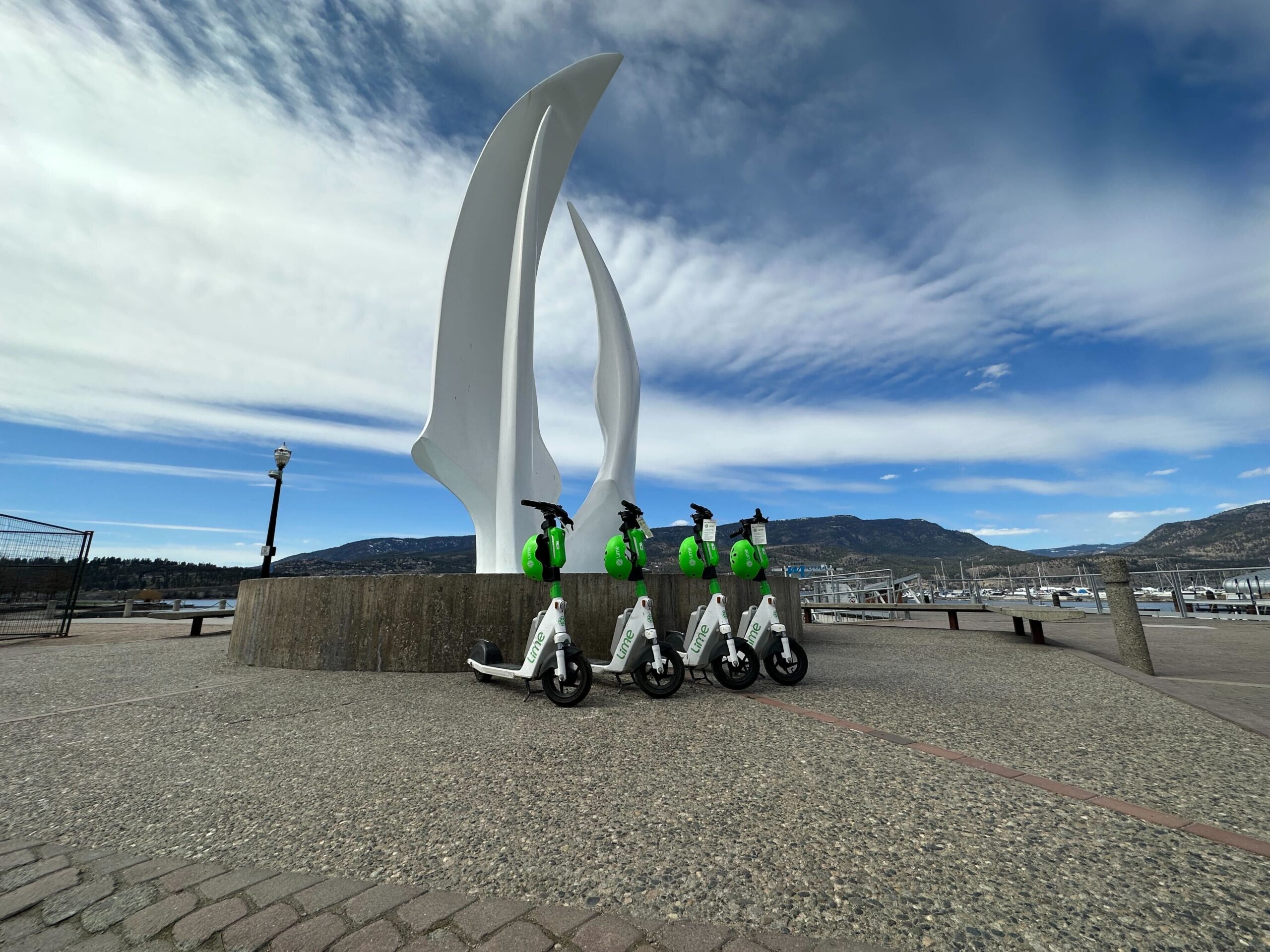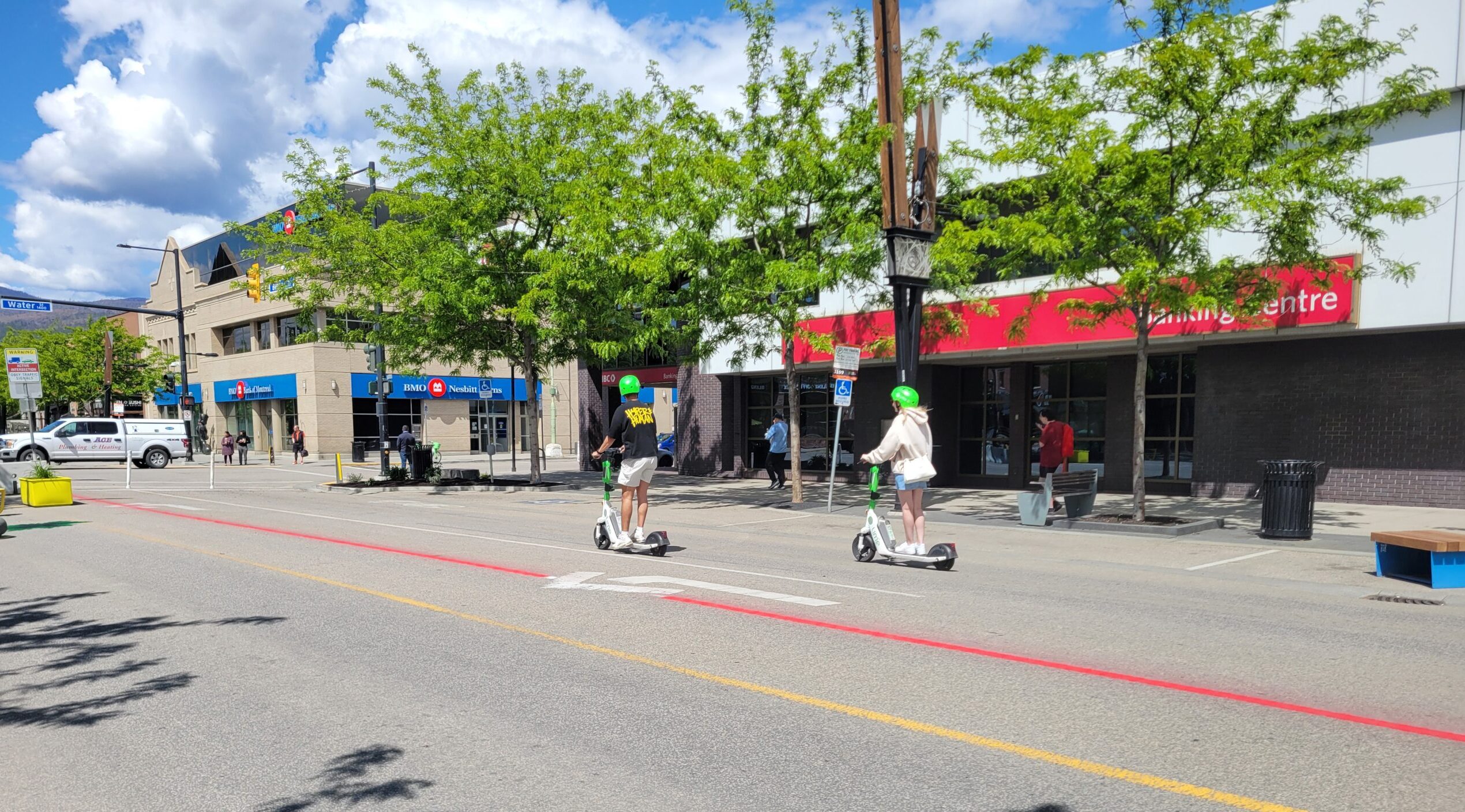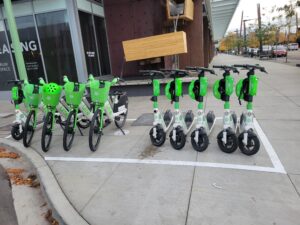
How the City of Kelowna welcomed electric kick scooters to its streets
Case Study
Published: May 28, 2025
Updated: n/a
Relevant Topics: Policy, Transportation
The City of Kelowna, with just over 160,000 residents, is the largest city in the BC Interior and is the region’s economic and tourism hub. Nestled along Okanagan Lake, it features a lively downtown urban centre with waterfront parks, modern developments, and cultural attractions. As its population expands, the city is investing in smart growth strategies that enhance connectivity, promote health and well-being, and align with their commitments to reduce emissions by 80% by 2050.
Published: May 28, 2025
Updated: n/a
Relevant Topics: Policy, Transportation
Climate Zone: 5
Problem
Kelowna’s 2040 Transportation Master Plan set a citywide target that by 2040, 25 percent of trips are made using sustainable modes, with the remaining 75 percent by vehicles. While their mode share is trending toward sustainable modes, the city is committed to reducing the growth of traffic congestion and emissions from transportation. To advance this, the City sought a micromobility solution that could reduce trips made by personal vehicles, especially during peak travel times, while complementing public transit and ensuring safety and accessibility for all residents.
As the community continues to grow and evolve, the City is keenly aware of a unique opportunity to introduce and support transit solutions that make it easier for residents to opt-in to alternative and active modes of transportation. Suzanne Therrien, an Active Transportation Planner with the City of Kelowna noted, “We know residents are looking for alternatives to personal vehicles. When people build new behaviours and routines, this is a key moment to introduce micromobility, so they see it as part of a suite of options available to them.” This is particularly important in a mid-sized community like Kelowna that doesn’t have the population density or size to sustain public transit with the frequency of larger urban centres. Shared micromobility like e-scooters and e-bikes therefore play a role in creating transportation options for shorter distances where there isn’t transit or transit isn’t frequent enough to be convenient.

Contributors

Suzanne Therrien
Active Transportation Planner
City of Kelowna

Jen Grebeldinger
Director, Communications & Engagement
Community Energy Association

Danielle Wiess
Director of Transportation Initiatives
Community Energy Association
Solution
In April 2021, Kelowna joined the Province of BC’s electric kick scooter pilot program and launched a shared micromobility pilot program consisting of both e-scooters and e-bikes. Kelowna’s program launched using a dockless parking system with rules around where and how scooters could be parked and has a contract with a single operator, Lime. Both e-scooters and e-bikes are offered in Lime’s fleet. Over time, the program parking system evolved to a hybrid approach, with mandatory dockless parking areas only in the dense downtown area.
The program was successful from the initial launch and ridership is increasing significantly each year. City staff in fact underestimated just how popular the program would be – Kelowna had a pedal bike share program in 2018 that had 30,000 trips over the course of a summer which is the same number of trips made in the first 2 weeks of the shared micromobility program.
By 2023, ridership more than doubled compared to the previous year (586,000 in 2023 compared to 238,000 in 2022), highlighting the growing popularity of micromobility as an everyday transportation option. Between April 2021 and Dec. 2024, over 1.6 million trips had been made on the shared bikes and scooters. Kelowna has the 6th highest ridership of 20 Canadian cities with shared micromobility and their per capita ridership is the highest in the country.
Cost
A testimony to the program’s success and ongoing support from Council and the community is the fact that no tax dollars subsidize the program – costs are covered by user fees and the provider. In the Transportation Association of Canada (TAC) report, “Shared Micromobility Services in Canadian Communities”, this is called a ‘managed’ delivery model. While municipal staff time is allocated to oversight and contract management (approximately half the salary of a full-time staff member), the City does not provide capital or operating funds.
Safety
The City gathers safety information from two sources: Interior Health (IH) and the operator, Lime. The City has collaborated with IH since 2021 to monitor the health and acute care impacts of the program with IH reporting on confirmed e-scooter related injury visits to the emergency room and providing recommendations on safety improvements. Importantly, IH reports all e-scooter related visits and is not able to distinguish between injuries incurred while riding a private versus a shared e-scooters. When the program launched in April 2021, there was a sharp rise in confirmed e-scooter related injuries, but this has reduced and stabilized over time (72 visits in 2021 down to 48 in 2022).
Between Jan. and Aug. 2023, there were 41 emergency room visits related to e-scooters (either privately owned or from the shared fleet). With 324,000 trips by shared e-scooter during that time, that means that more than 99.9% of trips finished without serious incident.
The City also introduced geofencing technology to enforce slow-speed, no-parking, and no-riding zones in critical areas including the downtown waterfront. Therrien added that, “just as with all forms of transportation, we take steps to mitigate safety issues, educate the public on safe and proper use, and create spaces that limit cross-modal conflict. E-scooters are new, and like every form of transportation, they have their unique benefits and risks to be aware of when moving around the city.”

Relationships and Communication
Every community is going to need to customize their micromobility projects to match their context and unique characteristics. But one thing that stood out to Therrien as replicable success factor is “having strong, positive working relationship with the service provider to share what’s working, what’s not and explore solutions together.” For Kelowna, this open communication with their provider enables flexibility to be responsive to community concerns and user needs. For example, in 2023 the program expanded to UBC Okanagan, where e-scooters quickly became an essential transportation option, generating 89,000 trips in 2023 alone—approximately 15% of total ridership.
The high usage right from the outset of the program launch in 2021 highlights the need for early and ongoing public education and outreach. City staff noted that even more resident awareness campaigns may have mitigated complaints and service requests from the public about e-scooter use and parking. Beyond communicating about parking compliance, both city staff and Lime plan to focus public education on safety and legal topics such as underage use and double riding. This direction is informed by public feedback, engagement, and recommendations from Interior Health.
Adaptability
“The City of Kelowna has been really nimble and adaptive over the 3 years of this program,” says Therrien, “we have tried to balance the convenience offered by shared micromobility while paying close attention to accessibility and safety.” Since most complaints concerned parking in the downtown core, the City evolved the downtown parking rules. Preferred parking areas were once voluntary but will now be mandatory to better manage accessibility issues and clutter. Outside of downtown where there is less density users can free float and follow dockless parking rules. Of this hybrid model, Suzanne says, “it really works for Kelowna—it reduces the investment in infrastructure and the preferred spots are also easy to shift, add, or remove based on feedback, evolving City needs, and usage patterns.”

Outcome
Kelowna’s shared micromobility program has been highly successful, with over one million trips taken since its inception, contributing to reduced congestion and emissions. A survey of shared e-scooter and e-bike riders indicate the percentage of trips replacing car travel increased from 33% in 2021 to 51% in 2023, preventing an estimated 900,000 kilometers of driving and providing an annual public benefit of $500,000 to $600,000 in terms of reduced emissions, collisions, and deferred infrastructure costs.
The program has also helped bring new people into the active transportation system. Staff reports indicate that roughly one-third of shared e-scooter riders said they never ride bicycles. This is an exciting finding and validates the role micro and shared mobility has in a holistic transportation system where residents have a variety of options to choose from as they shift beyond the car.
Safety concerns, a common hesitation in adopting e-scooters, have been mitigated through thoughtful implementation and continuous monitoring. Injury rates have stabilized and are now comparable to those of bicycles, demonstrating that e-scooters can be a safe and viable alternative mode of transportation.
Public perception of shared micromobility has also improved significantly. Initially, dissatisfaction with improper parking and safety concerns led to community complaints. However, as the program evolved with increased education, enforcement, and improved technology, service requests and complaints dropped by 99% since the pilot’s launch, signaling both growing public acceptance and successful modifications to the program over time. As with all changes to social norms, it’s important to frame and evaluate public concerns related to micromobility against transportation behaviours that we often accommodate or at least overlook (e.g., illegally parked cars). Therrien recommends anticipating that the program will change over time and there will be challenges as e-scooters are normalized in the urban landscape, “be willing to be flexible and adapt the service when appropriate based on public feedback, user data, and provider needs.”
The program has played a crucial role in complementing Kelowna’s public transit system by increasing transportation options in areas like suburban neighbourhoods where alternatives to driving (e.g., public transit, walking) are less viable. Moving forward, the City has shifted from a permit to a contract model, with a single operator entering a two-year contract with the City. According to a January 2024 Report to Council, “A single-operator model would maximize ridership, minimize staff time related to monitoring adherence to the contract terms, and provide the certainty needed for companies to invest in local staff and facilities.”
Contributors

Suzanne Therrien
Active Transportation Planner
City of Kelowna

Danielle Wiess
Director of Transportation Initiatives
Community Energy Association
Move from inspiration to implementation
With a great case study, you can learn what has worked in a community like yours. You can be inspired to bring an innovation home.
But you don't have to struggle to implement this on your own. Join the BC Local Government Peer Networks to gain the support you need to take inspiration to implementation.
Related Content
Electric scooters serving high density, transit-oriented areas in City of Coquitlam
With a focus on connecting transit riders to the first and last kilometer of their commute, the City of Coquitlam used the provincial electric kick scooter pilot to evaluate how shared micromobility would work in the community. From June 2023 to Dec. 2024, the pilot displaced 2% of the city’s private transportation emissions.


